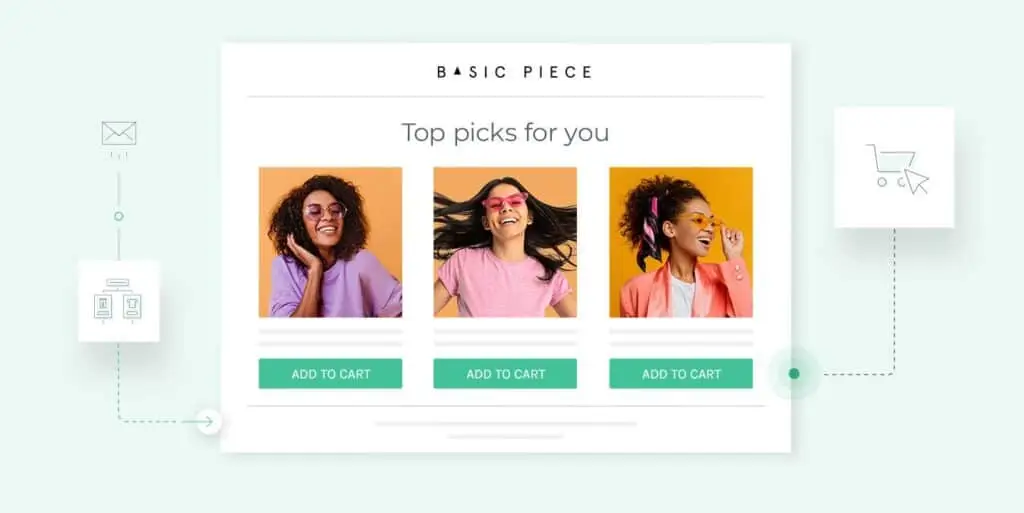Dynamic content has become essential in e-commerce, as 67% of consumers expect personalized online shopping experiences. According to insights from our recent whitepaper, “The New Era of Advertising Flyers in E-commerce and Retail,” dynamic content is a powerful tool to capture and retain customer interest, offering an interactive experience that static sites simply cannot match. By gradually incorporating dynamic elements, brands on a limited budget can elevate their customer experience, meet modern expectations, and see measurable conversion increases.
What is Dynamic Content?
Dynamic content refers to website elements that automatically adapt to individual user preferences and behaviors, creating a personalized experience in real-time. This type of content might include tailored product recommendations, interactive catalogs, or personalized offers. Data-driven and responsive, dynamic content addresses the unique interests of each visitor, making their experience on your site more relevant and engaging. For instance, companies using dynamic product recommendations have seen up to a 31% increase in revenue—a statistic that underlines the direct impact of personalization on e-commerce success.

The Risks of Static Sites in 2025
Static sites, which deliver the same content to every visitor, risk driving away potential customers. Research shows that 74% of consumers feel frustrated when a website doesn’t display relevant content, and sites that fail to personalize experiences often face higher bounce rates and lower conversion rates. In an environment where online shopping options are virtually endless, static content can leave customers feeling disconnected and ultimately push them toward competitors who offer tailored experiences.
The good news is that even simple dynamic content additions can go a long way. Here are practical, scalable ways to start incorporating dynamic content on your site:
- Personalize Product Recommendations to Boost Conversions
Personalized product recommendations are a straightforward and powerful way to introduce dynamic content on your site. You don’t need a massive overhaul or complex algorithms to get started. Many platforms, like Shopify and WooCommerce, offer plugins that allow you to create personalized recommendations based on browsing history or previous purchases. Highlight products like those customers have shown interest in or offer “frequently bought together” suggestions to increase average order value.

Source: Omnisend
Example: Amazon’s Recommendation Engine
Amazon attributes up to 35% of its revenue to its dynamic recommendation engine, which adjusts product suggestions in real-time based on customer activity. While Amazon’s system is highly advanced, you can take a simpler approach by using tools that fit your budget and still achieve impactful results.
- Make Your Most Valuable Marketing Assets Dynamic
Turning your core marketing assets—such as catalogs and flyers—into interactive, dynamic tools can transform the shopping experience. Static catalogs are limited in appeal, but digital, interactive versions allow customers to click on items, explore additional information, and even make purchases directly within the catalog. According to our whitepaper, shoppable, interactive catalogs can increase engagement by 25% compared to static alternatives.
Example: Using Dynamic Rules to Personalize Catalogs and Flyers
Dynamic catalogs offer even more possibilities with rule-based customization. Retailers can automatically adjust catalog content based on criteria like season, location, or trending events. For example, a retail brand could display cold-weather products on chilly days and shift to lighter, summer-friendly items during warmer periods. This rule-based capability ensures customers see relevant products that reflect their immediate needs. Such catalogs adapt to customer demand and encourage seasonal purchases, thereby driving higher conversions.

- Leverage Real-Time Pop-Ups and Exit-Intent Offers
Dynamic pop-ups and exit-intent offer target customers in real-time to encourage conversions. A simple exit-intent pop-up that provides a discount, special offer, or related product can remind visitors of items they’re considering or help close a sale. These pop-ups can reduce cart abandonment and increase conversion rates by up to 15%.
Example: Sephora’s Targeted Pop-Ups
Sephora uses exit-intent pop-ups to retain customers who are about to leave their site, offering discounts or reminding visitors of items in their cart. This real-time engagement captures customer interest at a crucial moment, often converting undecided browsers into buyers.

Source: Claspo
- Enhance Trust with Real-Time Customer Reviews and Stock Updates
Displaying real-time customer reviews and stock updates is another impactful way to use dynamic content. Studies show that 93% of consumers find reviews influential when making purchasing decisions, and displaying recent, relevant reviews can build trust and provide social proof. Additionally, real-time stock updates like “Only 3 left in stock!” create urgency, which can prompt faster purchasing decisions.
Example: Airbnb’s Dynamic Reviews
Airbnb updates customer reviews on accommodation pages in real-time, showing the most recent experiences to help potential renters make informed decisions. This level of personalization provides credibility and encourages more confident booking choices, a technique that any e-commerce site can adopt with customer feedback.
- Continuously Optimize with Data-Driven Insights
One of the most valuable aspects of dynamic content is the ability to track customer interactions and continually optimize for better results. Analytics tools like Google Analytics or Hotjar can reveal user behavior trends, such as which recommendations get the most clicks or which pages have high bounce rates. Start with A/B testing different dynamic elements and adjust them based on what resonates with your audience. Over time, you’ll gain insights that will help you refine your dynamic content strategy and increase conversions.
Getting Started with Dynamic Content in 2025
Integrating dynamic content doesn’t require a huge investment or complex tools. By gradually implementing personalized recommendations, interactive catalogs, pop-ups, and real-time updates, you can provide the engaging experiences customers expect while driving higher conversions.
For a deeper dive into how to implement these strategies effectively, download our whitepaper, “The New Era of Advertising Flyers in E-commerce and Retail,” and discover five proven dynamic content strategies to boost your e-commerce sales. Start transforming your site today to meet customer expectations, maximize engagement, and drive conversions.


